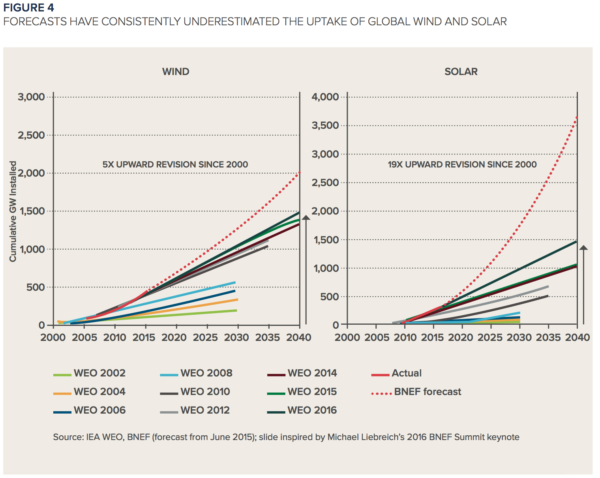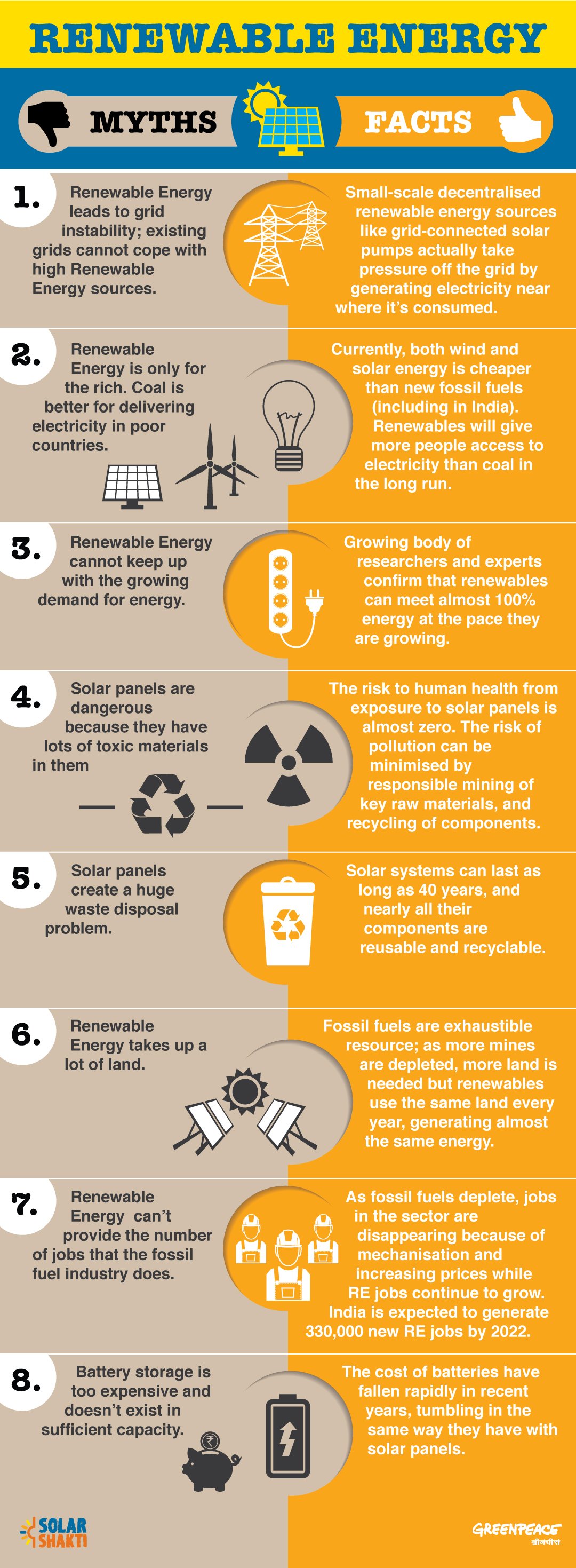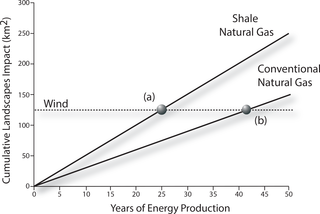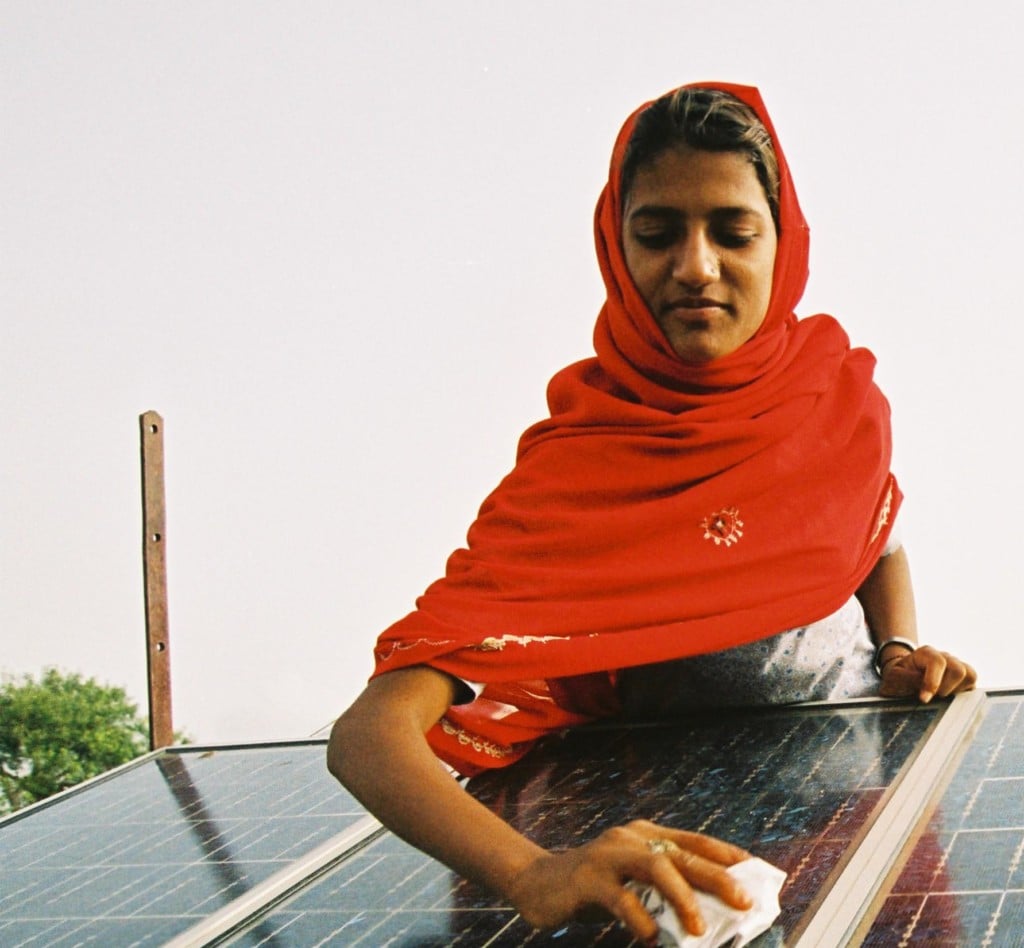There are two perspectives to every story; of a protagonist and an antagonist. In the real world, differentiating between the two is rather difficult. More often than not, market realities, consumer choices and government policies are the factors coloring both sides grey. While the polluting and exhaustive nature of fossil fuels such as coal is known, the social and economic sides of renewable energy sources such as solar are still not well understood. In the changing global climate, renewable energy is increasingly being adapted for a sustainable future. Experts are clear that mankind cannot rely upon coal-based energy much longer. It is, therefore, time we break some commonly held myths with scientific facts and research proofs.
Myth: Renewable Energy cannot keep up with the growing demand for energy.
Fact: The rapid growth of renewables has blind-sided almost everyone in the past 15 years, including so-called expert voices like BP and the IEA (see figure 4).

A growing body of research shows that 100% renewable energy is possible, and there is plenty of potential capacity: one Stanford University study calculated that “Wind in developable locations can power the world about 3–5 times over and solar, about 15–20 times over.” There is huge untapped potential for solar, wind, wave and geothermal energy. But mindsets and power structures need to change. There needs to be the political will to make this transition happen.
In 2017, 178GW of renewable energy electricity capacity was added, more than two thirds of global power growth, led by 97GW of solar power, more than half of it in China. Solar’s success offset slower growth in offshore wind and hydropower.
As prospects for India’s coal sector are falling, so is the price of renewable energy. India’s RE target of 227 GW by 2022 is highly ambitious with 100 GW of solar installed which proves the country’s motivation to shift from coal to renewables being quite high.

Renewable Energy – Myths Vs Facts
Design: Penmi Rungsung/Greenpeace India
Myth RE is only for the rich. Coal is better for delivering electricity in poor countries.
Fact This is the key argument of the coal industry, but it’s one that has been demolished by numerous studies. Even the IEA, which has always underestimated the growth of RE, says that renewables will give more people access to electricity than coal. Nor does coal lift people out of poverty, it locks them into it. A 2017 report by Oxfam was clear on this point:
“More coal will drive more people into poverty through the devastating consequences of climate change and the direct toll of coal mining and burning on local communities, including loss of land, pollution, and health impacts”.
Globally, 1.2 billion people have no access to electricity, but big coal projects won’t help them. Most of them (84%) live in rural areas, with no access to a centralised electricity grid. The costs of extending the grid, plus the coal-powered electricity, vastly exceed the costs of off-grid solutions like small-scale wind or solar PV.
Bottomline is that wind and solar are increasingly becoming cheaper than new fossil fuels in more than 30 countries (including India) and they continue to fall, with none of the real costs of coal (air pollution, contaminated water, health impacts, the risk of stranded assets).
Myth: Solar panels are dangerous because they have lots of toxic materials in them
Fact: The risk to human health from exposure to the materials in solar PV panels is almost zero. The risk of pollution can be minimised by responsible mining of key raw materials, and recycling of components – which is already happening in many countries.
Research has shown that the pollution associated with renewable energies like solar, wind and hydro is far less than the pollution linked to fossil fuels, with a very low environmental impact despite the need for raw materials. One study concluded: Even though there are toxic compounds used in the manufacturing of most solar panels, the generation of electricity from solar energy is significantly safer to the environment and workers than production of electricity from coal, natural gas, and nuclear fission.
Myth: Solar panels create a huge waste disposal problem
Fact: Solar systems can last as long as 40 years with proper maintenance, reusing and recycling. Since nearly all their components can be recycled and re-used, which many companies are already doing.
For solar PV, as much as 90% of the glass and 95% of the semiconductor (rare earth content) can be recycled. Thin film companies such as First Solar offer robust recycling programs to reclaim such modules at the end of their useful lives. The European Union requires that 85% of all used PV modules be collected and at least 80% of the module must be recycled. The majority of PV producers in the EU offer voluntary take-back and recycling of PV panels. In the US, the Solar Energy Industries Association (SEIA) is collaborating with its European counterpart to develop a recycling program model for the US.
Myth: RE takes up a lot of land.
Fact: Renewables use the same land every year – they don’t move. But fossil fuels create energy sprawl, as mines are depleted and wells dry up. So coal, oil and gas are constantly demanding more and more land.

Land sprawl: the cumulative land required to produce 1 TWhr/year for 3 energy sources
The footprint of renewables (the land they actually use up, rather than the total area covered by a wind or solar farm) is tiny. For ground-mounted solar, some agricultural, grazing and even beekeeping uses are possible. But otherwise, solar is readily mounted on buildings, carports, and other structures taking up no land at all.
Importantly, renewable energy can also be located on brownfields (abandoned or underused industrial land) or other commercial and industrial locations, which significantly reduces concerns about land use.
When it comes to powering entire countries solely with renewable energy, analysis shows the land requirements are not a barrier. Researchers at Stanford University calculated that land requirements across 139 countries to achieve 100% renewable energy would total less than 1% of the total land area – mostly for onshore wind, geothermal, utility-scale PV and CSP plants.
Myth: RE can’t provide the number of jobs that the fossil fuel industry does.
Fact: There are no accurate figures for the number of people employed worldwide in fossil fuel industries. But there are already 9.8 million people employed worldwide in renewable energy. Job numbers are growing and there is huge potential in countries which are only just embarking on the transition to renewables. IRENA says there could be 24 million jobs in RE worldwide by 2030. The IEA (which has always underestimated the growth of RE) predicts that by 2030, more than half of those working in the energy sector will be employed in renewables.
In its 2017 review, the Abu Dhabi-based intergovernmental body promoting renewable energy, IRENA estimated that globally the jobs in the sector increased by 2.8% over 2015. Most of the renewable energy jobs are in China, Brazil, United States, India, Japan, and Germany, with 62% of the renewable energy jobs located in Asia.
According to a World Resource Institute study, India’s target of adding 160 GW of solar and wind energy capacity by 2022 is expected to generate more than 330,000 new jobs over the next five years. These jobs would be in construction, project commissioning and design, business development, and operations and management.
In contrast, jobs in fossil fuels, particularly coal mining, are disappearing (and have been for some time) because of mechanisation and market forces. In the oil industry, jobs rise and fall with the oil price making employment in that sector unreliable and difficult to predict.

Myth: RE leads to grid instability; existing grids cannot cope with high RE sources
Fact: The flexibility of renewables can actually stabilise the grid because RE sources can change their output rapidly to respond to changes in demand. Small-scale distributed (decentralised) renewable energy sources (like small scale solar) actually take pressure off the grid by generating electricity near where it’s consumed. The problem of grids being out of balance is more likely to come from power plants which can’t respond quickly – ie fossil-fuel or nuclear plants.
A recent study from Stanford University’s Institute for Energy modelled different scenarios for nearly 140 countries and concluded there was no technical or economic barrier to transitioning the world to 100% renewable energy with a stable grid and at low cost. Another study from IEEFA showed how nine countries and regions (including Uruguay, South Australia, Germany and California) have moved to high market shares of wind and solar without compromising reliability or undercutting supply.
An independent study by energy consultants MJ Bradley found that RE could actually strengthen the grid by ensuring sufficient capacity, maintaining local voltage at the required rate, helping balance the grid and creating a more flexible and diverse supply system.
Myth: Battery storage is too expensive and doesn’t exist in sufficient capacity
Fact: Battery storage is developing rapidly, with investment up six-fold since 2011. Costs are tumbling, they’ve dropped 19% a year for the past 5 years. Storage encompasses a number of technologies and approaches, eg. pumped hydro, hydrogen and thermal storage. When people talk about the cost of energy storage, they usually mean the cost of battery technology. The cost of batteries have fallen rapidly in recent years, tumbling in the same way they have with solar panels.
Penmi Rungsung is a Creative Communications Campaigner at Greenpeace India.
Arpita Bhagat is a Digital Engagement Campaigner at Greenpeace India.

The Sun is a renewable source of energy and is one of the cleanest sources.
